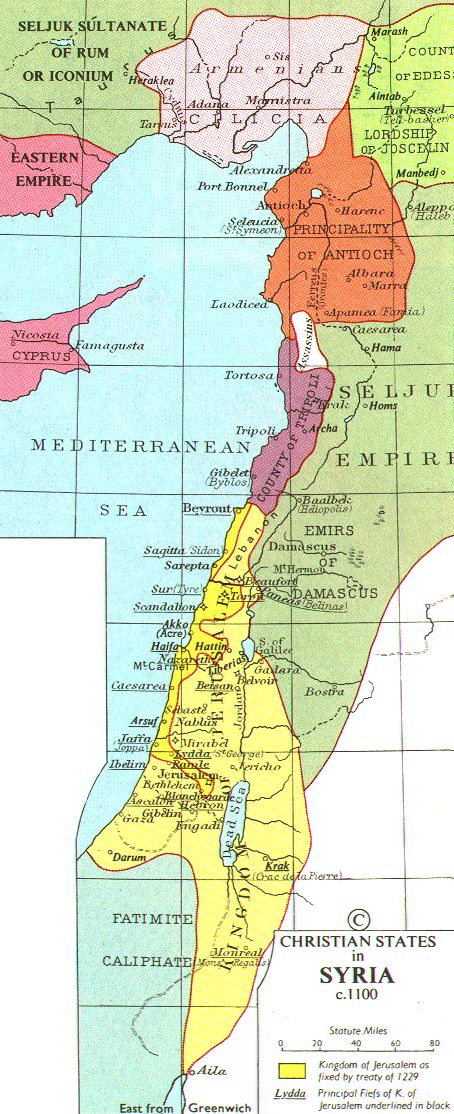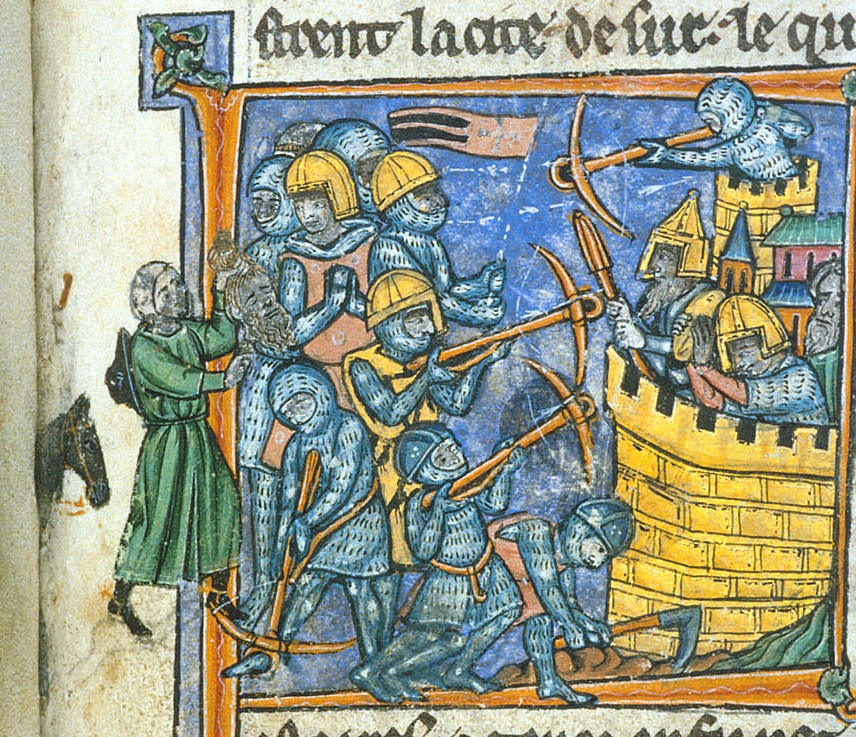|
Siege Of Tyre (1124)
The Venetian Crusade of 1122–1124 was an expedition to the Holy Land launched by the Republic of Venice that succeeded in capturing Tyre. It was an important victory at the start of a period when the Kingdom of Jerusalem would expand to its greatest extent under Baldwin II of Jerusalem. The Venetians gained valuable trading concessions in Tyre. Through raids on Byzantine territory both on the way to the Holy Land and on the return journey, the Venetians forced the Byzantines to confirm, as well as extend, their trading privileges with the empire. Preparation Baldwin of Bourcq was a nephew of Baldwin I of Jerusalem and the Count of Edessa from 1100 to 1118. In 1118 his uncle died and he became Baldwin II of Jerusalem. In the Battle of Ager Sanguinis, fought near Sarmada on 28 June 1119, the Franks suffered a disastrous defeat by the forces of Ilghazi, the ruler of Mardin. Later that year Baldwin regained some territory, but the Franks were seriously weakened. Baldwin a ... [...More Info...] [...Related Items...] OR: [Wikipedia] [Google] [Baidu] |
Crusades
The Crusades were a series of religious wars initiated, supported, and sometimes directed by the Latin Church in the medieval period. The best known of these Crusades are those to the Holy Land in the period between 1095 and 1291 that were intended to recover Holy Land, Jerusalem and its surrounding area from Muslim conquests, Islamic rule. Beginning with the First Crusade, which resulted in the recovery of Jerusalem in 1099, dozens of Crusades were fought, providing a focal point of European history for centuries. In 1095, Pope Pope Urban II, Urban II proclaimed the First Crusade at the Council of Clermont. He encouraged military support for List of Byzantine emperors, Byzantine emperor Alexios I Komnenos, AlexiosI against the Seljuk Empire, Seljuk Turks and called for an armed pilgrimage to Jerusalem. Across all social strata in western Europe, there was an enthusiastic response. The first Crusaders had a variety of motivations, including religious salvation, satisfying feud ... [...More Info...] [...Related Items...] OR: [Wikipedia] [Google] [Baidu] |
Battle Of Ager Sanguinis
In the Battle of ''Ager Sanguinis'', also known as the Battle of the Field of Blood, the Battle of Sarmada, or the Battle of Balat, Roger of Salerno's Crusader army of the Principality of Antioch was annihilated by the army of Ilghazi of Mardin, the Artuqid ruler of Aleppo on 28 June 1119. Background Antioch and the other Crusader States were constantly at war with the Muslim states of Northern Syria and the Jazeerah, principally Aleppo and Mosul. When Ridwan of Aleppo died in 1113, there was a period of peace, at least for a few years. However, Roger of Salerno, who was ruling Antioch as regent for Bohemond II, did not take advantage of Ridwan's death; likewise, Baldwin II, count of Edessa, and Pons, count of Tripoli, looked after their own interests and did not ally with Roger against Aleppo. In 1115, Roger defeated a Seljuk Turkish invasion force led by Bursuq ibn Bursuq at the Battle of Sarmin. In 1117, Aleppo came under the rule of the Artuqid atabeg Ilghazi. In 1118, R ... [...More Info...] [...Related Items...] OR: [Wikipedia] [Google] [Baidu] |
Map Crusader States Ca
A map is a symbolic depiction emphasizing relationships between elements of some space, such as objects, regions, or themes. Many maps are static, fixed to paper or some other durable medium, while others are dynamic or interactive. Although most commonly used to depict geography, maps may represent any space, real or fictional, without regard to context or scale, such as in brain mapping, DNA mapping, or computer network topology mapping. The space being mapped may be two dimensional, such as the surface of the earth, three dimensional, such as the interior of the earth, or even more abstract spaces of any dimension, such as arise in modeling phenomena having many independent variables. Although the earliest maps known are of the heavens, geographic maps of territory have a very long tradition and exist from ancient times. The word "map" comes from the , wherein ''mappa'' meant 'napkin' or 'cloth' and ''mundi'' 'the world'. Thus, "map" became a shortened term referring to ... [...More Info...] [...Related Items...] OR: [Wikipedia] [Google] [Baidu] |
List Of Rulers Of Aleppo
The rulers of Aleppo ruled as kings, emirs and sultans of the city and its surrounding region since the later half of the 3rd millennium BC, starting with the kings of Armi, followed by the Amorite dynasty of Yamhad. Muslim rule of the city ended with the Ayyubid dynasty which was ousted by the Mongol conquest in 1260. The rulers of Yamhad used the titles of king and Great King, while the Hittite dynasty monarchs used the titles of king and viceroy. The Emirate of Halab was established in 945 by the Hamdanid dynasty and lasted until 1086, when it became a sultanate under the Seljuq dynasty. The sultanate was sometimes ruled together with Damascus under the same sultan. The Artuqids rulers used the titles of Malik and emir, as did the Zengid rulers which added the title atabeg. The Ayyubid monarchs used the titles of sultan and malik. The dates for Yamhad and the Hittite Dynasties are proximate and calculated by the Middle chronology. Yamhad Dynasty Yamhad was the name of ... [...More Info...] [...Related Items...] OR: [Wikipedia] [Google] [Baidu] |
Belek Ghazi
Belek Ghazi (''Nuruddevle Belek'' or ''Balak'') was a Turkish bey in the early 12th century. Early life His father was Behram and his grandfather was Artuk Bey, an important figure of the Seljuk Empire in the 11th century. He was a short-term governor of Suruç (now a district center in Şanlıurfa Province of Turkey). The city was captured during the First Crusade in 1098. He took part in the Seljuk expedition to Antakya which was recently lost to Crusaders. But the campaign ended in failure. Beylik in Harput In 1112, Belek captured Harput (an ancient city near to present day Elazığ in Turkey) from Mengüceks. He founded a beylik. This beylik is now known as the Harput branch of the Artukids (the other two being the Hasankeyf branch of Sökmen and Mardin branch of Ilghazi). Next year he married Ayşe Hatun, widow of Anatolian Seljuk sultan Kilij Arslan. By this prestigious marriage, he formed family ties with the Seljuk family.Belek Gazi In 1120, Belek together with D ... [...More Info...] [...Related Items...] OR: [Wikipedia] [Google] [Baidu] |
Corfu
Corfu (, ) or Kerkyra ( el, Κέρκυρα, Kérkyra, , ; ; la, Corcyra.) is a Greek island in the Ionian Sea, of the Ionian Islands, and, including its small satellite islands, forms the margin of the northwestern frontier of Greece. The island is part of the Corfu regional unit, and is administered by three municipalities with the islands of Othonoi, Ereikoussa, and Mathraki.https://corfutvnews.gr/diaspasi-deite-tin-tropologia/ The principal city of the island (pop. 32,095) is also named Corfu. Corfu is home to the Ionian University. The island is bound up with the history of Greece from the beginnings of Greek mythology, and is marked by numerous battles and conquests. Ancient Korkyra took part in the Battle of Sybota which was a catalyst for the Peloponnesian War, and, according to Thucydides, the largest naval battle between Greek city states until that time. Thucydides also reports that Korkyra was one of the three great naval powers of fifth century BC Greece, alo ... [...More Info...] [...Related Items...] OR: [Wikipedia] [Google] [Baidu] |
Domenico Michiel
Domenico Michiel was the 35th Doge of Venice. He reigned from 1117 to 1130. In August 1122 Domenico Michiel led a Venetian fleet of 100 vessels and around 15,000 men for the defense of the Holy Land. The fleet sailed under the flag of St. Peter, which the Pope had sent to Michiel. Over the winter the fleet set siege to the Byzantine island of Corfu. The siege was cancelled in the spring when news arrived that King Baldwin II of Jerusalem had been captured by the Artuqids, and that the Kingdom of Jerusalem had subsequently been invaded by the Fatimids of Egypt. The Venetian fleet went to the defense of Jerusalem and defeated the Egyptian fleet off of the Syrian coast. The Venetians then landed at Acre; from there Michiel went to Jerusalem, where the ''Pactum Warmundi'' was signed granting Venice privileged trade concessions, tax freedoms, and even partial ownership of some cities within the Kingdom of Jerusalem. On the return journey to Venice, the fleet looted Rhodes, attacked the ... [...More Info...] [...Related Items...] OR: [Wikipedia] [Google] [Baidu] |
Doge Of Venice
The Doge of Venice ( ; vec, Doxe de Venexia ; it, Doge di Venezia ; all derived from Latin ', "military leader"), sometimes translated as Duke (compare the Italian '), was the chief magistrate and leader of the Republic of Venice between 726 and 1797. Doges of Venice were elected for life by the Venetian nobility. The ''doge'' was neither a duke in the modern sense, nor the equivalent of a nobility, hereditary duke. The title "doge" was the title of the senior-most elected official of Republic of Venice, Venice and Republic of Genoa, Genoa; both cities were republics and elected doges. A doge was referred to variously by the titles "My Lord the Doge" ('), "Most Serene Prince" ('), and "Serene Highness, His Serenity" ('). History of the title Byzantine era The office of doge goes back to 697. The first historical Venetian doge, Orso Ipato, Ursus, led a revolt against the Byzantine Empire in 726, but was soon recognised as the () and (a honorific title derived from the Greek w ... [...More Info...] [...Related Items...] OR: [Wikipedia] [Google] [Baidu] |
First Council Of The Lateran
The First Council of the Lateran was the 9th ecumenical council recognized by the Catholic Church. It was convoked by Pope Callixtus II in December 1122, immediately after the Concordat of Worms. The council sought to bring an end to the practice of the conferring of ecclesiastical benefices by people who were laymen, free the election of bishops and abbots from secular influence, clarify the separation of spiritual and temporal affairs, re-establish the principle that spiritual authority resides solely in the Church and abolish the claim of the Holy Roman Emperor to influence papal elections. The council was significant in size: 300 bishops and more than 600 abbots assembled at Rome in March 1123, and Callixtus II presided in person. During the council, the decisions of the Concordat of Worms were read and ratified. Various other decisions were promulgated. Background The First Lateran Council was called by Pope Callixtus II whose reign began on February 1, 1119. It demarcate ... [...More Info...] [...Related Items...] OR: [Wikipedia] [Google] [Baidu] |
Pope Callixtus II
Pope Callixtus II or Callistus II ( – 13 December 1124), born Guy of Burgundy, was head of the Catholic Church and ruler of the Papal States from 1 February 1119 to his death in 1124. His pontificate was shaped by the Investiture Controversy, which he was able to settle through the Concordat of Worms in 1122. As son of Count William I of Burgundy, Guy was a member of and connected to the highest nobility in Europe. He became archbishop of Vienne and served as papal legate to France. He attended the Lateran Synod of 1112. He was elected pope at Cluny in 1119. The following year, prompted by attacks on Jews, he issued the bull '' Sicut Judaeis'' which forbade Christians, on pain of excommunication, from forcing Jews to convert, from harming them, from taking their property, from disturbing the celebration of their festivals, and from interfering with their cemeteries. In March 1123, Calixtus II convened the First Lateran Council which passed several disciplinary decrees, such as ... [...More Info...] [...Related Items...] OR: [Wikipedia] [Google] [Baidu] |



